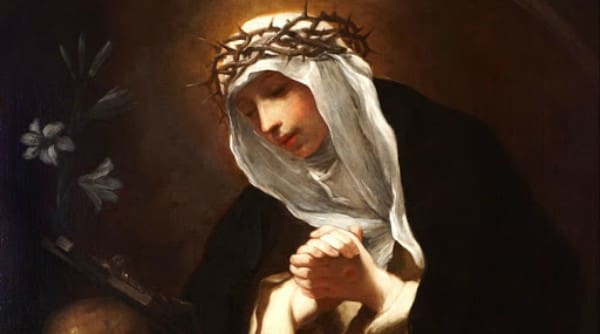The life of Catherine Benincasa was interwoven of three distinct threads: contemplation, active charity, and self-immolation. The first and last are constant in the histories of mystics of all creeds, the latter often in an extraordinary degree, as in devotees of some of the sects of India, in the medieval saints of whom Peter of Alcantara may be taken as a type, or the German mystic Suso, in Catherine’s own century, or the much later founder of the Sacré Coeur, devoured, as she would declare, by an unassuageable fever for suffering. The present century revolts from pain, and the tortures that minds like these inflict on themselves appear absurd and grotesque. To those who were or are possessed with the longing for them, pain appears in quite another light, and their self-immolation, though it may break physical laws that are now recognized as much God’s laws as are moral ones, and is apt to lead to perilously morbid conditions of mind, has a claim to veneration and a right to be understood. Should they not, they argue, seek to enter into something of what their Lord bore for them? Is it not possible to come nearer to Him there? Might it not be that voluntary suffering expiates sin in themselves and others? Can it not help to free the soul from the shackles of the flesh? Again, in the Middle Ages when men’s passions were so strong and so unbridled that the body might well be regarded as a wild beast that must be subdued by force lest it should kill the soul, mortification had its necessary place. Dante, who soared above his contemporaries like an eagle, meditated on the mystery of the Incarnation and thus could speak of “the honorable body,” but to almost everyone else in the Middle Ages, it was either a master or slave.
Had Catherine never left her cell, it is impossible to say into what state of mind she would have slipped, but her obedience to the call to an active life kept the balance even, and shielded her from two great dangers to which the visionary is exposed: such sensuousness as shocks us in the rhapsodies of the nun Gertrude and others of that school, both medieval and modern or, on the other hand, the equally painful prudery of saints who thought that the very presence of a woman, even were she their mother, threatened their purity.
There was a noble large-mindedness in Catherine. Thrown into a world of flagrant vice and crime, she faced it as fearlessly and as unharmed as did Beatrice within the gates of the Inferno, and moved in it pure as a lily. She could realize that there are many ways of coming to God, and good in all men, a conviction that gave her a wonderful power over sinners. She knew too that no one system has a monopoly of perfection. Devoted as she was to the Dominicans, she by no means thought their rule desirable for all who chose monastic life, and often recommended another order to those who sought her advice.
Again, almost alone in that day she held the word “country” to mean Italy, not merely her own city, and when appealed to by Florence or Pisa she was just as ready to help them as if they had been friends instead of enemies to Siena. This was a view that exposed her to suspicion, and during the first years of that public life that was so short and contained so much, she was obliged more or less to take account of this feeling. The Mantellate of Pisa repeatedly urged her to visit them, but at the time there was great tension between their city and Siena, and she found an only-too-valid excuse for refusal in her ill health. Her splendid constitution had given way under the fatigue and anxiety that she endured while the plague lasted.
Her austere life tried her, and she had so accustomed herself to live almost without food that now, when finding that her abstinence provoked comment and suspicion that she ate in secret, she would fain have eaten like other people, but she could not do it. There was a moment when she seemed dying, and the thought was joy to her, but there was much work to do, and she set her will to recover and did so to a considerable degree, though thenceforward she lived and labored in constant pain, which she could not always hide. Though accepting it gladly, she was learning that health and strength are gifts from Heaven, not to be cast away, and she who in girlhood had forced herself to drive sleep from her now wrote to Alessia dei Saracini, “The night is for vigil, after thou hast paid the debt of sleep to thy body.” To the end of her life Catherine was growing in wisdom and spiritual experience. Hesitation as to going to Pisa was cut short by a command from Pope Gregory XI to go there and undertake certain negotiations with the magistrates, and no difficulties were raised by the authorities in Siena, who could hope that at the same time she might dispose the Pisans to restore a castle in Sienese territory unjustly occupied by them, together with the important port of Talamone. This journey was a far weightier matter than anyone guessed at the time, for with it Catherine stepped from private to public life and became a leading factor in the sphere of politics. How early in her career she had had any direct communication with Gregory is uncertain, but that much earlier than would be supposed from Raimondo’s life of her she must have been recognized as important may be gathered from the remarkable fact that as soon as 1372 Gregory asks advice from her through his legate and apostolic nuncio in Tuscany, a kinsman of his whom he had made governor of Perugia. His letter has unfortunately disappeared, but as she says, “In reply to the three questions which you ask on behalf of our sweet Christ on earth,” it is clear that the legate wrote to her at the Pope’s desire. These questions were apparently as to what measures were most necessary for the new Pope to make, amazing as it is to find the head of Christendom asking such advice not from his cardinals or his bishops, but from a woman, and a woman of the people. Her reply is that he must look to two great evils that are corrupting the Church: firstly, excessive nepotism, but this, she hopes, is beginning to disappear, thanks to the prayers offered up that it may cease; secondly, slackness in checking the vices and luxury in the Church. “In urging you to work for Holy Church,” she writes,
I was not thinking of temporal matters; care for them is all very well, but what you ought chiefly to labor at, together with the Holy Father, is to do everything possible to drive out of the sheepfold those wolves, those demons incarnate, who think only of good cheer, splendid feasts and superb equipages. . . . I conjure you, even if it cost your life, urge the Holy Father to stop these iniquities, and when the time comes for choosing pastors and cardinals, let not money and flattery and simony have anything to do with their election, but beg him as far as may be to look only to the good qualities of those proposed, heeding not whether they be nobles or peasants.
The overtenderness of Gregory toward his relations was already patent, and Catherine’s outspoken allusion to it must have startled the legate, who had just benefited by it. Whether the Pope was allowed to hear the whole of her letter we do not know, but until the last months of his life, her honesty never offended him.
+
This article is adapted from a chapter in Saint Catherine of Siena and Her Times by Margaret Roberts which is available from Sophia Institute Press.
Art for this post on St. Catherine of Siena: Cover and featured image used with permission.






